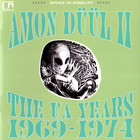Amon Düül II

- Genres:
- Avant-Garde, Pop/Rock
- Meta styles:
- Art-Rock/Experimental, Modern Composition
- Styles:
- Art Rock, Experimental, Kraut Rock, Prog-Rock
Amon D??l II emerged in 1968 out of the scene of hippies and squatters in Munich, Germany, but their strong interest in music led them to go their own way. They took their name from the old Egyptian name Amon, being an Egyptian sun god, and D??l, a character from Turkish fiction. Their personnel changed constantly, but maybe the most permanent members were Renate Knaup (vocals), Chris Karrer (guitar, violin), John Weinzierl (guitar), Peter Leopold (drums), Falk Rogner (organ, synthesizer).
After several successful albums with a style that reached from long improvisation to more structured rock songs they split. Later they tried several resurrections but none of them brought back the old days of glory.
Amon Duul was initially an anarchist commune, but it split into two factions, Amon D??l I and Amon D??l II. ADI was more politically inclined, but ADII preferred making music. Their anarchist tendencies are clearly seen in their music, especially on the albums Yeti, Tanz Der Lemminge, and Wolf City.
They can be seen as having two distinct periods in their glory days, the improvisational period and the compositional period. The improvisational period consisted of albums such as Phallus Dei and Yeti, and, to a lesser extent, Tanz Der Lemminge. These albums all featured long, improvisational tracks (Phallus Dei was entirely improvised, and disc two of Yeti was as well, but Tanz Der Lemminge only featured one improvisation). Their compositional period starts with Carnival in Babylon and is highlighted by Wolf City. In this period, the band moved to more structured composed pieces. Many fans saw this as a poor move, but some believed that Amon Duul II proved that they were just as good at composing as they were at improvising.
- Sort by

Düülirium
- Year:
- 2014
- Tracks:
- 4
- Bitrate:
- 320 kbps

Anthology CD2
- Year:
- 2005
- Tracks:
- 14
- Bitrate:
- 320 kbps

Anthology CD1
- Year:
- 2005
- Tracks:
- 11
- Bitrate:
- 320 kbps

Manana
- Year:
- 2000
- Tracks:
- 12
- Bitrate:
- 320 kbps

The UA Years: 1969-1974
- Year:
- 1999
- Tracks:
- 16
- Bitrate:
- 320 kbps

The Best Of 1969-1974
- Year:
- 1997
- Tracks:
- 17
- Bitrate:
- 192 kbps

Kobe (Reconstructions)
- Year:
- 1996
- Tracks:
- 6
- Bitrate:
- 320 kbps

Eternal Flashback
- Year:
- 1996
- Tracks:
- 1
- Bitrate:
- 320 kbps

Nada Moonshine
- Year:
- 1995
- Tracks:
- 13
- Bitrate:
- 320 kbps

Surrounded By The Bars
- Year:
- 1993
- Tracks:
- 12
- Bitrate:
- 128 kbps
 A.R. & Machines
A.R. & Machines  Faust
Faust  Gong
Gong  Guru Guru
Guru Guru  La Dusseldorf
La Dusseldorf  Area
Area  Ash Ra Tempel
Ash Ra Tempel  Birth Control
Birth Control  Captain Beefheart
Captain Beefheart  Genesis
Genesis  Henry Cow
Henry Cow  NEU!
NEU!  Pfm
Pfm  Robert Wyatt
Robert Wyatt  Embryo
Embryo  Slapp Happy
Slapp Happy  The Soft Machine
The Soft Machine  Träd, Gräs och Stenar
Träd, Gräs och Stenar  Os Mutantes
Os Mutantes  Kraftwerk
Kraftwerk  Pink Floyd
Pink Floyd